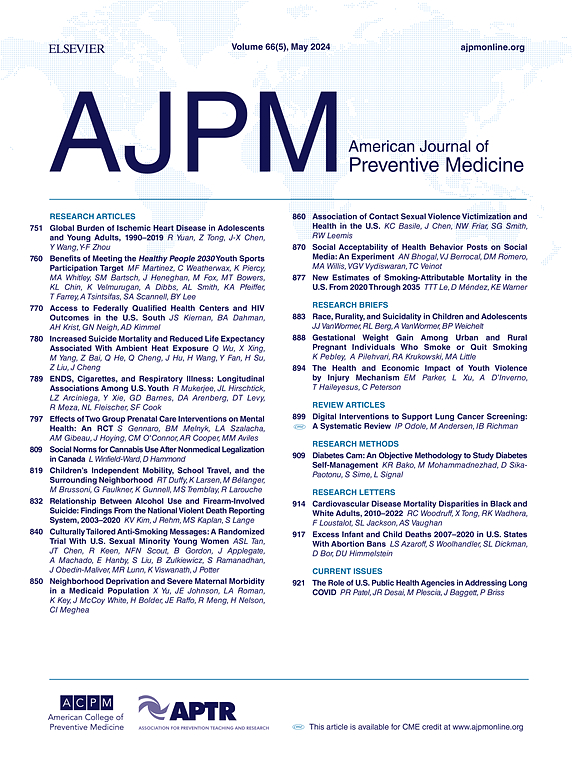Foregone Preventive Care and Unmet Mental Healthcare Needs Among U.S. Youth
IF 4.3
2区 医学
Q1 MEDICINE, GENERAL & INTERNAL
引用次数: 0
Abstract
Introduction
Given the youth mental health crisis, this study examines racial and ethnic disparities of foregone preventive care, unmet mental healthcare needs, and difficulty accessing mental healthcare among youth with common mental health problems.
Methods
A cross-sectional analysis was conducted using the 2022 National Survey of Children’s Health (NSCH), examining U.S. youth aged 8–17 years with parent-reported anxiety, depression, or behavioral problems. NSCH survey weights were utilized, and ORs were estimated for each racial and ethnic group across foregone preventive care, unmet mental healthcare needs, and difficulty obtaining mental healthcare, adjusting for age, sex, language, income, parental education, and insurance.
Results
Among the weighted sample of 6,608 youth with common mental health problems, 14.2% of children with common mental health problems had forgone preventive care, 15.1% had unmet mental healthcare needs, and 59.2% had difficulty obtaining mental healthcare. Per parental report, Black children had 1.59 (95% CI=1.01, 2.51) times the odds of foregoing preventive care in the past year compared to White children. Asian children had 2.32 (1.18, 4.48) times the odds of unmet mental healthcare compared to White children. There were no significant differences in difficulty obtaining mental healthcare across race and ethnicity.
Conclusions
Racial and ethnic disparities exist in accessing preventive and mental healthcare among children with parent-reported mental health conditions. Black youth have higher rates of foregone preventive care, while Asian youth have higher unmet mental healthcare needs compared to White youth. Further research should explore barriers and facilitators of collaborative care to reduce youth mental healthcare disparities.
在美国青少年中被忽视的预防保健和未满足的精神保健需求。
引言:鉴于青少年心理健康危机,本研究探讨了种族和民族的差异,放弃预防保健,未满足的心理保健需求,以及难以获得心理保健的青少年常见的心理健康问题。方法:采用2022年全国儿童健康调查(NSCH)进行横断面分析,研究了8-17岁的美国青少年,他们的父母报告了焦虑、抑郁或行为问题。利用NSCH调查权重,估计各种族和族裔群体的优势比,包括先前的预防保健、未满足的精神保健需求和获得精神保健的困难,调整年龄、性别、语言、收入、父母教育程度和保险。结果:在6608名有常见心理健康问题的青少年加权样本中,14.2%的常见心理健康问题儿童放弃预防保健,15.1%的儿童心理保健需求未得到满足,59.2%的儿童难以获得心理保健。根据父母报告,黑人儿童在过去一年接受预防性护理的几率是白人儿童的1.59倍[95% CI, 1.01-2.51]。亚裔儿童的心理健康未满足率是白人儿童的2.32倍[1.18-4.48]。在获得精神卫生保健的困难方面,不同种族和民族没有显著差异。结论:在父母报告有心理健康状况的儿童中,在获得预防保健和心理保健方面存在种族和民族差异。与白人青年相比,黑人青年放弃预防性保健的比例更高,而亚洲青年的精神保健需求未得到满足的比例更高。进一步的研究应探讨合作护理的障碍和促进因素,以减少青少年心理保健差距。
本文章由计算机程序翻译,如有差异,请以英文原文为准。
求助全文
约1分钟内获得全文
求助全文
来源期刊

American Journal of Preventive Medicine
医学-公共卫生、环境卫生与职业卫生
CiteScore
8.60
自引率
1.80%
发文量
395
审稿时长
32 days
期刊介绍:
The American Journal of Preventive Medicine is the official journal of the American College of Preventive Medicine and the Association for Prevention Teaching and Research. It publishes articles in the areas of prevention research, teaching, practice and policy. Original research is published on interventions aimed at the prevention of chronic and acute disease and the promotion of individual and community health.
Of particular emphasis are papers that address the primary and secondary prevention of important clinical, behavioral and public health issues such as injury and violence, infectious disease, women''s health, smoking, sedentary behaviors and physical activity, nutrition, diabetes, obesity, and substance use disorders. Papers also address educational initiatives aimed at improving the ability of health professionals to provide effective clinical prevention and public health services. Papers on health services research pertinent to prevention and public health are also published. The journal also publishes official policy statements from the two co-sponsoring organizations, review articles, media reviews, and editorials. Finally, the journal periodically publishes supplements and special theme issues devoted to areas of current interest to the prevention community.
 求助内容:
求助内容: 应助结果提醒方式:
应助结果提醒方式:


